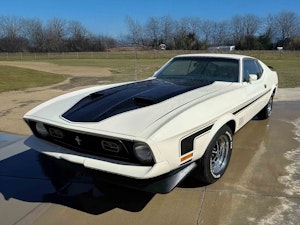Media | Articles
How the 512S Modulo went from Pininfarina concept to registered “Ferrari sedan” in New York
Whether you count it from the fifty years since Pininfarina first presented it at the Geneva Motor Show in a shade of pearl light blue, or even the six years since Jim Glickenhaus managed to buy it, the Ferrari Modulo’s journey from futuristic concept to road-legal car has been a long one. The 1970s showpiece was never designed to get out of neutral, but as we saw last week during its shakedown at Northern Italy’s Cremona Circuit, the Modulo wouldn’t disappoint in motion either.
Since he bought the concept car from a borderline bankrupt Pininfarina in 2014, it’s been Glickenhaus’ vision that the Modulo be made into a real, usable road car, complete with a working Ferrari V-12. The ambitious project has had its obstacles, including one just last year when the car caught fire in Monaco. That mishap was due to a bad muffler design and some heavy backfiring, courtesy of the concept’s rich-running Can Am engine.
Pininfarina’s masterpiece is credited to the creator of the Fiat 130 Coupé, Paolo Martin, a man who must also have been a huge fan of Syd Mead’s concept art throughout the 1960s. The end of that decade was a flourishing time for Pininfarina. Once Enzo Ferrari was kind enough to send over 512S #27, a chassis originally built as a spare for the 25 homologation 512S and 612 Can Am race cars and assembly kits, Pininfarina could begin work on a radical concept for the 1970 Geneva Motor Show. The car was to become the Modulo, a Ferrari so low and wide that getting in and out of it via a sliding cupola almost felt natural.
20200225142148)
20200224151439)
Marketplace
Buy and sell classics with confidence
20200224151451)
20200224151458)
Ferrari couldn’t sell 512S chassis #27 even after it was upgraded to become 612 Can Am #864, but that didn’t mean that Maranello wouldn’t strip the chassis destined for Pininfarina of all engine and gearbox internals, leaving a coffee table of a 5.0-liter V-12 in the middle of a naked frame. Once Pininfarina finished the custom body and interior, spraying the car pearl light blue for Geneva, the Modulo went to black and then white, continuing its tour with the Osaka Expo in 1970, and a party in Mexico City the following year. Yet, after hauling home quite a few design awards, this spaceship landed back at Pininfarina in Italy, where it was for years to come, displayed next to its complex wooden buck.

After purchasing the Modulo, Jim Glickenhaus immediately started wondering what he could do to make this prototype not just road-legal, but also safe enough to drive at events, or to a local restaurant with his wife. After all, every car in the Glickenhaus collection is registered, insured, and when the stars align, even driveable. The Modulo wasn’t going to be an exception just because some believed its partly covered wheels make it impossible to steer. (True, the car did not steer when Glickenhaus first got it, but that was only because at some point beforehand somebody managed to mount its steering rack upside down.)
The Modulo first drove in June, 2018, and again at Pebble Beach later later in the year. Then, in the summer of 2019, it sustained the aforementioned exhaust fire damage, resulting in some charred paint and a melted tail light. That setback might not seem like such a big deal for the kind of person who runs his own self-established racing team, but at the time it provided fuel for those voices who shouted that Glickenhaus should have left the concept as it was. He could build a Modulo replica instead for his occasional weekend cruises, right?




Having seen the 512S Modulo both before and after its conversion, I also had the pleasure of seeing it roll out to a track for the first time in half a century. Glickenhaus’ modifications have not sacrificed its concept-car looks whatsoever, but the sensation of seeing the car at speed elevates the whole experience. Every vehicle looks different on the move, and given that it has the backbone of a V-12 Ferrari racing car, the Modulo was destined to leave the house at one point.
Which is why it’s good that when Glickenhaus bought his Ferrari P4, it came with a box of rare spare parts. Given Ferrari’s decision to essentially strip the car before sending it to Pininfarina, the Modulo didn’t pack much under its 24-hole engine cover. In order for it to run like a proper 512S once more, Scuderia Cameron Glickenhaus’ engineers at Podium Advanced Technologies had quite a few things to figure out.




Machined pistons and a boxful of Ferrari’s P3/4 and 512S parts off the shelf certainly help, but that alone doesn’t make a Modulo road-legal in the state of New York, where Glickenhaus is based. According to its registration it now flies as a “1970 Ferrari sedan”, due to the fact that the state doesn’t have a “one-door coupe” category. Sedan it is, then.
Beyond the correct engine and its original gearbox, new modifications include electronically operated radiator doors that also allow access to the fuel cap, period “Sebring” mirrors, a wiper system that’s now asymmetrical and functional, fans in the air ducts for cabin ventilation, fresh yet period-correct BF Goodrich tires, and a completely re-engineered muffler system with internal flame arrestors and tips that are half an inch longer than before, so they extend out of the body. SCG decided to end its relationship with the manufacturer of the previous muffler, which obviously failed to tame the Can Am V-12 in Monaco.






Jumping into the Pininfarina Modulo is obviously an event in any context, but imagine the excitement in the air in Italy as Glickenhaus walked around the car and chatted with his engineers, knowing that the task ahead was the part they’d all be anticipating for months. The Modulo needed to burn off some fresh paint from the pipes, make sure all twelve cylinders run while the oil gets to temperature, and promptly exit the track before the lunch break slot ended at the Cremona Circuit. After lunch, it was the brand-new 004C’s time again.
Remember, the last time Jim Glickenhaus drove his Modulo, the situation got toasty.




This time, thankfully, was different. Once the wind blew away the one-of-a-kind Ferrari’s muffler smoke, the Modulo shifted into first, confirming its roadworthiness by accelerating, turning, and then stopping for the pits, all moments before getting the green light towards Cremona’s eleven corners.
With SCG’s engineers counting no more than ten of twelve cylinders firing, all ears were focused on how high Glickenhaus would go with the revs before he had to make his way back to the pits. Then, out he went onto the track, only to drive back in a short while with an open canopy.






This 1970 Ferrari 512S in disguise, the wild concept known as the Pininfarina Modulo, was in that moment finally back on a track for the first time since 1969. Yes, it ran on ten cylinders for this initial outing, because apparently it’ll need the same trick ignition Glickenhaus uses on his P4, which makes it so the V-12 doesn’t soak the spark plugs, allowing it to run stable even under 5000 rpm. SCG’s crew will also need to re-engineer an originally BMW-made latch, so that the canopy will stay shut when the body starts shaking on the road. Again, these are concerns that Pininfarina, hard at work through the winter of 1970, did not need to worry about when the Modulo was being prepared to sit parked on a Geneva show stand.
Taking a moment to discuss crucial issues of the Modulo is time well spent for all involved. Glickenhaus gives feedback, but he is happy with how the car drives in general. His engineers are brainstorming, coming up with one great solution after another. The Modulo’s Ferrari heart is still warm from its first few minutes on a racing circuit, something it’s been waiting for since it was just #27, a spare chassis in Ferrari’s backyard. And for us, the quiet bystanders, this cooling time gives an opportunity to discover even more details of this amazing Pininfarina study, before it goes into a trailer again and disappears into the distance.
For some reason, the Modulo features two spherical pieces in the cabin. One acts as an orientable aerator, while the other on the right is a mysterious control board. Except it’s a sphere, and it works. Everything works now, and in a way, it’s been fifty years coming, arriving right as Pininfarina celebrates its 90th in Turin, Italy. The only place where magical spheres can control Can Am Ferraris. Even ones registered as sedans in New York.










20200225144348)
20200225144403)
20200225144410)
20200225144417)
20200225144423)
20200225144429)
20200225144436)
20200225144518)
20200225144524)
20200225144531)
20200225144537)
20200225144543)
20200225144549)
20200225144554)
20200225144600)
20200225144608)
20200225144615)
20200225144623)
20200225144630)
20200225144637)
20200225144645)
20200225144709)
20200225144717)
20200225144727)
20200225144744)
20200225144811)
20200225144832)
20200225144856)
20200225144920)
20200225144949)
20200225145018)
20200225145049)
20200225145116)
20200225145139)
20200225145225)
20200225145308)
20200225145340)
20200225145411)

